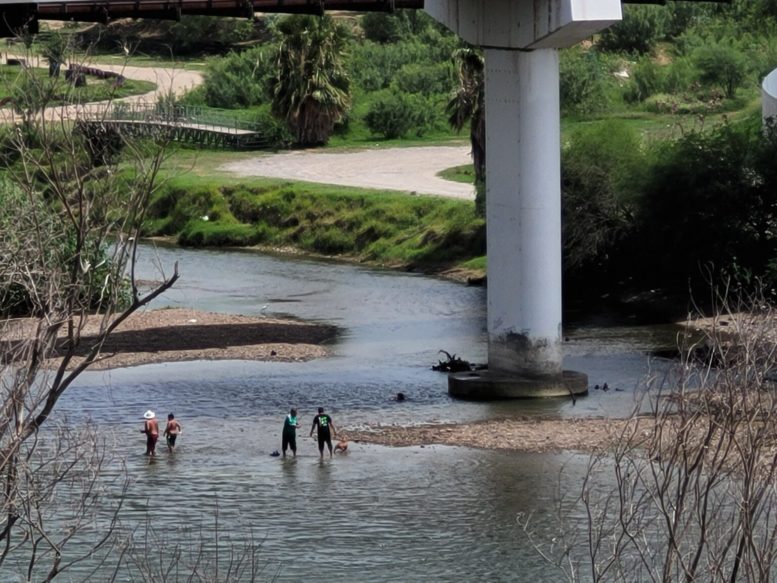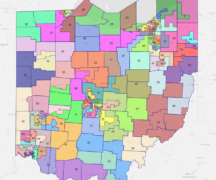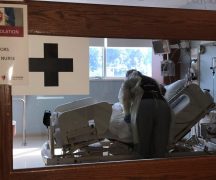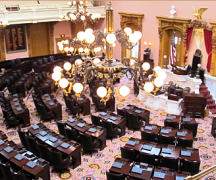ROMA, Texas — Four people, presumably Mexican citizens, could be seen in the Rio Grande River last Wednesday just off the shore of Ciudad San Miguel Aleman and below the sandstone bluffs of Roma, called the “most Mexican town” in the United States.
The historic town is where Elia Kazan shot much of the 1952 Marlon Brando flick “Viva Zapata.” John Steinbeck, its screenwriter, wanted to shoot the movie about the peasant revolutionary in Mexico, but Kazan and the producers figured Roma was a close enough depiction.
Now Roma and its neighbors in the Rio Grande Valley are the subject of another drama, but much of it appears to be playing out on the internet, on cable television and among political figures located far to the north.
Apprehensions of undocumented immigrants have spiked at the border this year. But despite claims like that of Texas gubernatorial candidate Don Huffines that “our nation is being invaded,” the four in the river on Wednesday didn’t appear to be sneaking into the United States.
Two were in swimsuits and two others were seen with a dog. The group appeared to be trying to escape the sweltering 93-degree heat, not the vast network of Border Patrol, National Guard troops and state troopers that Ohio and five other states have sent personnel to augment.
Exactly where those visiting personnel from Ohio are stationed and just what they’re doing, however, is difficult to figure out. No Guard troops or out-of-state police were to be seen during a trip last week, and government officials won’t provide details.
Heated claims
Ohio Gov. Mike DeWine sent 14 Highway Patrol officers to serve a two-week stint at the border at state taxpayer expense. Another 115 Ohio National Guard members are stationed there on the federal dime, with DeWine committing to send 185 more Guardsmen and women later this year.
Greg Abbott, Texas’s politically embattled governor, in June joined Arizona Gov. Doug Ducey, a fellow Republican, in making a dire plea for help enforcing the law on their states’ southern borders.
Such sweeping criminality wasn’t in evidence during a drive last week along 200 miles of the border where illegal crossings have been heaviest during this year’s surge from Central America.
From Laredo to Brownsville, Texas state troopers were only a light presence along the road and troopers from Ohio, Iowa and Nebraska weren’t seen at all.
Journalists who cover the immigrant surge say that illegal crossings usually happen late at night instead of during the heat of the day. And one said police now may be deployed in the desolate, the 90-mile region north of the border, looking for people who have already crossed.
But the present scarcity of troopers along the border is in stark contrast to 2014 and 2015, when Abbott and his predecessor, Rick Perry, originally surged them there.
They claimed the cops were needed to fight surging crime, but their statistical case to support the $400 million-a-year program was full of holes.
It cited a hair-raising number of crimes committed by “criminal aliens,” but it didn’t weigh the relative severity of the crimes. Nor did it separate out people who illegally crossed borders other than the one with Mexico, much less in Texas. And it didn’t distinguish between illegal crossers and those who had overstayed their visas — who were estimated to be 40% of the whole.
That original surge of troopers wasn’t shown to reduce crimein the historically peaceful Valley. But it did produce lots of traffic stops — and loud complaints from the overwhelmingly Hispanic community of unfair harassment.

– Marty Schladen, Ohio Capital Journal
This time around, the troopers are much less visible. And, asked what the statistical case is for out-of-state troopers there, the Texas Department of Public Safety didn’t even try to make one.
The agency “is committed to securing our border under the direction of Texas Governor Greg Abbott,” DPS Press Secretary Ericka Miller said in an email. “We are grateful to every agency that has offered assistance in making Texas and the United States more secure, and will continue integrating other law enforcement agencies into our operations at the border as appropriate.”
She also declined to say where the out-of-state troopers were or describe what they were doing.
“While the department does not discuss operational specifics, we will continue to monitor the situation as it unfolds in order to make real-time decisions to protect the people and property of Texas,” Miller said.
Misperception
While Abbott, Miller, Perry and others might imply that there’s uncontrolled lawlessness at the border, people who actually live there have long been weary of that false description.
“We’ve not had a spike in violent crime,” said Sgt. Frank Medrano, spokesman for the Hidalgo County Sheriff’s Office, which patrols the most populous county in what is by far the Border Patrol’s busiest sector in Texas right now. “I know the media want to show that it’s the wild, wild west down here. But that’s not the case. We’re a very safe community.”
In pleading for other states to send cops, the governors of Texas and Arizona referred to “the cartels” and “their deadly fentanyl.” Similarly, DeWine said he knew from his prior stint as Ohio attorney general “that the vast majority, almost all the drugs that are coming into the state of Ohio, come across the southern border. So we have a real interest in securing the southern border.”
But visiting troopers are unlikely to do much about the influx of illegal drugs. The great majority of drugs aren’t crossing the Rio Grande on the backs of undocumented immigrants; they’re being driven through the international ports of entry — making it a customs issue, not an immigration one.
The perception of a war-torn border is a myth, said Javier Villalobos, mayor of McAllen, the largest city in Hidalgo County .
“Life here is fantastic,” he said. “It is great. Our economy’s fine. We’re the seventh-safest city in the country. We don’t have many issues.”

– Marty Schladen, Ohio Capital Journal
But just as surging cops to the border for dubious reasons isn’t new, it isn’t new for the state’s Republican governor to exaggerate the danger of border communities in his own state. Twice in 2010, Perry went before television cameras and falsely claimed that a car bomb that had detonated in violence-torn Juarez had actually exploded in El Paso, which also is consistently rated as one of the country’s safest cities. Perry’s office said at the time he’d “misspoken.”
In fact, it’s much safer than some of the cities that the Ohio troopers are coming from. El Paso’s population is more than 75% the size of Columbus’s, but it had just 14% as many murders last year. McAllen has about 150,000 people and last year recorded three homicides. Dayton, with a similar population of 140,000, reported 48.
Some border residents see a connection between such false rhetoric and a 2019 massacre in which a Dallas-area 21-year-old posted a racist screed and then drove to El Paso, killing 23 and injuring 23 others — as much carnage in a few minutes as the border city normally sees in a full year.
“Words have consequences. (Former President Donald Trump) has made my community and my people the enemy,” U.S. Rep. Veronica Escobar, an El Paso Democrat, said after the shooting. “He has told the country that we are people to be feared, people to be hated.”
Refugee crisis
Which isn’t to say there are no problems at the southern border.
Poverty, coronavirus, hurricanes, crime and political corruption have combined to push people particularly from the Northern Triangle of Central America on a desperate journey across Mexico and often to the international bridges south of McAllen.

– U.S. Customs and Border Protection
Also said to have driven this year’s surge is word on the street in Guatemala, Honduras and El Salvador that incoming President Joe Biden will be more accommodating than Trump, who ordered some minors to be separated from their parentsat the border.
Last year, while Trump was still in office, the U.S. Centers for Disease Control and Prevention also issued an order allowing the expulsion of asylum seekers to keep out the coronavirus.
Unaccompanied minors have usually been allowed into the country. The CDC order forced some families to make excruciating decisions, including one by a Salvadoran mother to send her 12-year-old daughter across the Rio Grande at La Joya on a raft with smugglers, the Associated Press reported in May.
Asylum seekers still are flooding in. Despite the summer heat, federal officials on Friday reported that as of June, 1.1 million apprehensions had been made at the southern border this fiscal year. The last time the number of apprehensions eclipsed 1 million was 2006, the Washington Post reported.
And while the flood of asylum seekers aren’t necessarily causing a crime wave, they do cause problems, Villalobos, the McAllen mayor said.

-Marty Schladen, Ohio Capital Journal
After unaccompanied minors and families turn themselves in at the bridges, immigration officials “transport them to our downtown area, drop them off, then they get tested for Covid and if they’re positive, they get placed at a hotel nearby,” Villalobos said. “If they’re not positive, Catholic Charities takes over. They house them, feed them for just one night and hopefully, they’re transported out” to find places to stay while their asylum claims are processed.
Despite the surge of migrants, the numbers have been manageable, the mayor said. But “if they lift (the CDC restrictions allowing deportation primarily of single, adult men) we’re going to be in a world of hurt.”
The city helps out of concern for public safety. But it’s not a duty Villalobos believes it should have to shoulder.
“What we’re a little concerned about is that we’re stuck doing something that we shouldn’t be doing,” he said. “This is not a municipal issue. This is a federal issue.”
Confusing the issue
To some experts, governors sending more cops to the border seems like an attempt to make a humanitarian crisis seem like a crime wave.
“Obviously it’s a political opportunity,” said Charis E. Kubrin, a criminologist at the University of California, Irvine. “Immigration and crime independently are two of the most politicized issues in our country.”
She added that further politicization will do little to solve crime — or illegal immigration.
“It’s huge and it’s structural and no amount of harsh criminal-justice policy — including deportation policy, including criminal-justice directives aimed at immigrants — is going to fix the structural issues that caused the problem in the first place,” Kubrin said.
When he announced that he was sending state troopers to the border, DeWine said, “We were asked to play a small part in (securing the border), and I said yes, I think it’s in Ohio’s interest to do that. I think it’s the right thing to do.”
But his office didn’t respond to questions for this story, including a request to answer the criticism that sending cops to the border was a political ploy.
He also didn’t say where Ohio’s Guard troops were or what they were doing at the request of the federal government.
Stephanie Beougher of the Ohio National Guard said, “There are members of the 1484th Transportation Company on federal Title 10 active duty orders supporting the Southwest Border operations. Requests for further information including media coverage would need to be directed to Joint Task Force North at Fort Bliss, Texas, which is the federal command for the mission.”
Joint Task Force North didn’t respond to a request for information. Nor did the Biden White House.
For Villalobos, the McAllen mayor who has to deal with the humanitarian crisis, the answer is immigration reform — if not comprehensive, then piecemeal. He called on members of Congress to stop perpetuating stalemate just so they can have a political issue.
Back in Roma, all the controversy seemed far away.
Last week, a woman was there, admiring the Spanish colonial architecture in the sleepy town square.
She said she frequently stands on the bluff overlooking Mexico and has never seen any unrest. The town and its neighbors don’t any need for other states’ cops, said the woman who declined to give her name.
“The governor we have is making a play right now for his re-election and he is pandering to all the Trump supporters,” she said. “If you’re a Trump supporter, I’m sorry. That’s how I feel.”





